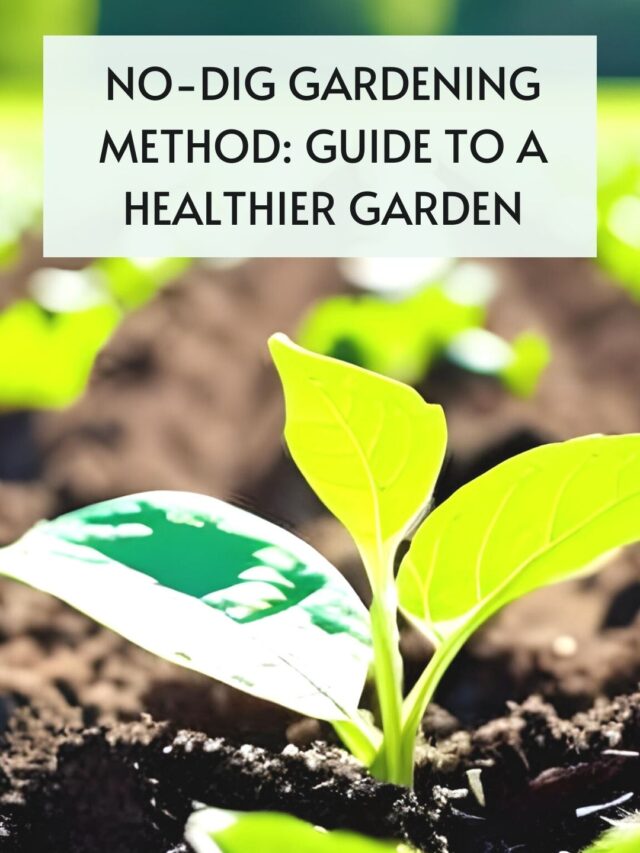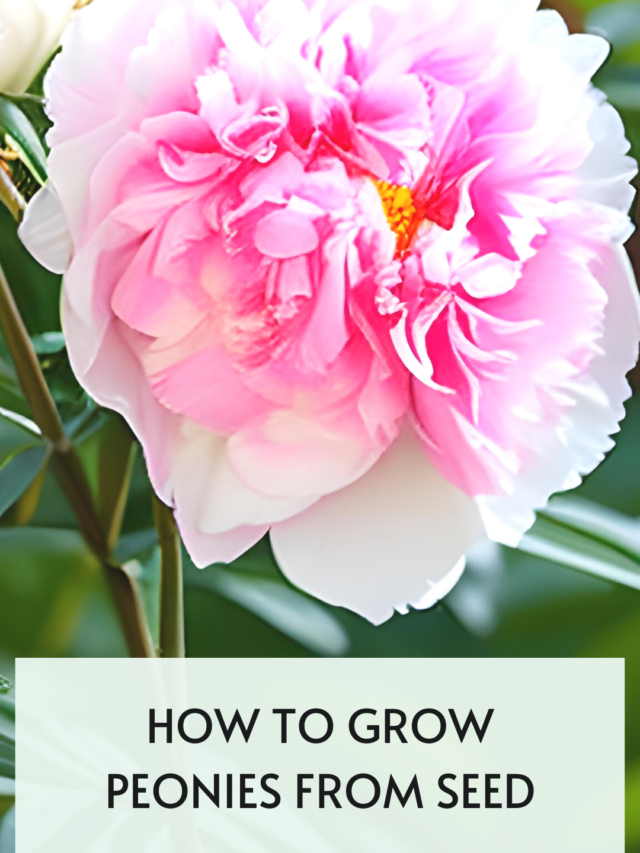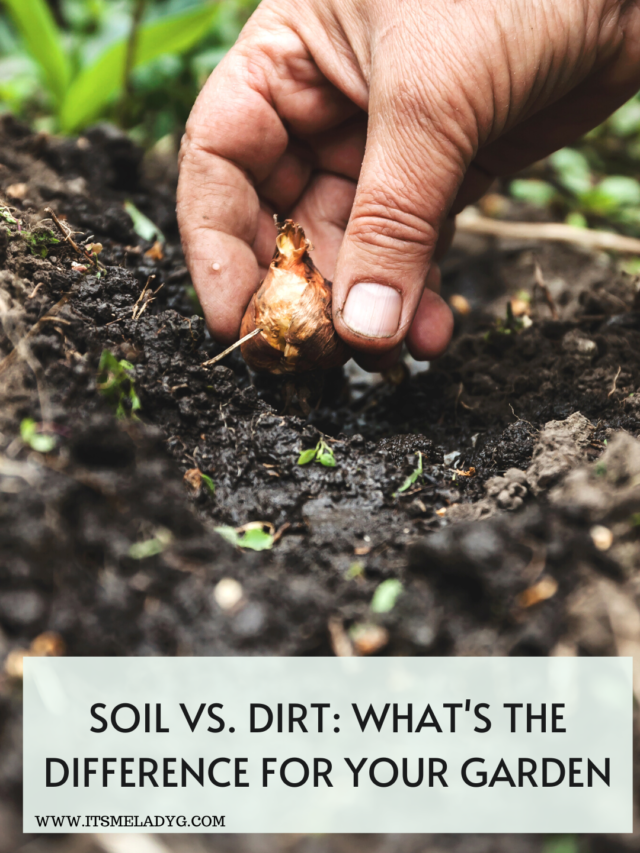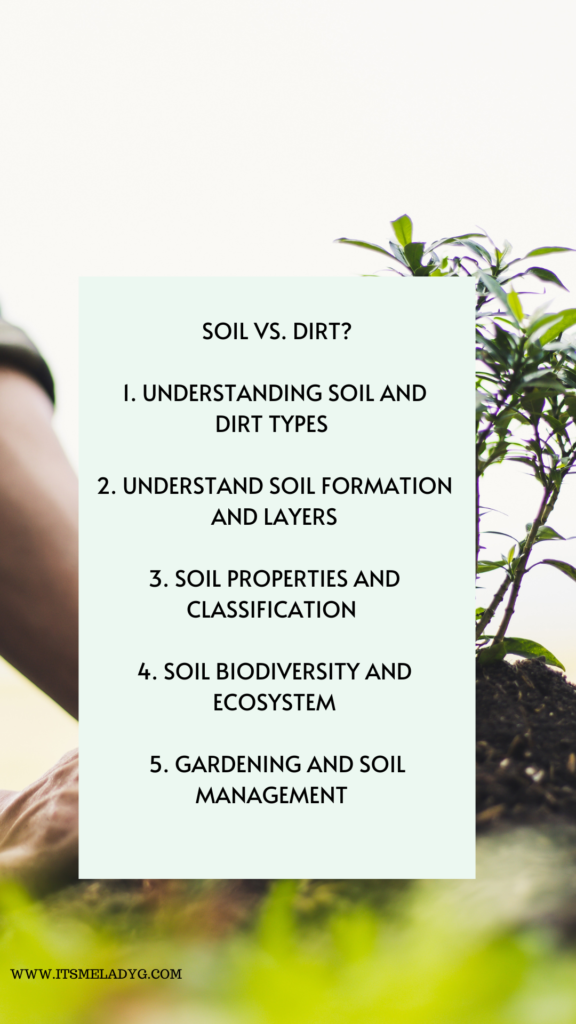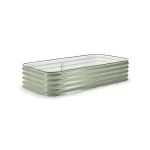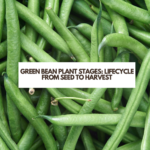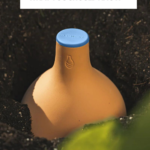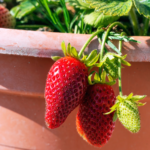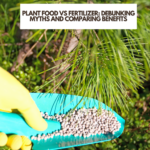Are you wondering what’s the difference between soil vs. dirt? When it comes to the ground beneath our feet, the terms “soil” and “dirt” are often used interchangeably. However, these two substances have distinct differences and properties, making them essential in different aspects of our daily lives. Understanding the distinction is crucial, particularly for gardeners, farmers, and environmentalists, and this article aims to clarify the confusion between the two.
Soil is a complex, living ecosystem composed of organic matter, minerals, water, air, and a diverse community of microorganisms. It plays an essential role in supporting plant growth and serves as the foundation of the world’s food systems, biodiversity, and natural recycling processes. As a result, healthy soil is critical for maintaining a balanced and sustainable environment.
On the other hand, dirt is essentially displaced soil – it is soil that has lost the properties that make it essential for supporting life. Unlike soil, dirt does not contain the essential nutrients, minerals, and living organisms that are required for healthy plant growth.
It is often seen as less valuable and less desired, particularly in gardening or farming contexts. Consequently, learning to discern between good soil and dirt can be an integral part of maintaining thriving ecosystems and promoting environmental sustainability.
Understanding Soil and Dirt
Definition and Composition
Soil is a mixture of organic matter, minerals, water, and air that supports the growth of plants. It consists of different layers, each having unique characteristics and functions. Soil formation involves various processes, including weathering of rocks, accumulation of organic matter, and activity of microorganisms.
Dirt, on the other hand, refers to displaced soil or loose, unconsolidated material. It lacks the structure and essential elements necessary for plant growth. In essence, dirt is soil that has been removed from its natural context and has lost its value as a growing medium.
The composition of the type of soil varies from one location to another but generally consists of:
- Minerals: sand, silt, and clay particles derived from the breakdown of rocks
- Organic matter: decomposed plant and animal material
- Water: essential for various biological, chemical, and physical processes
- Air: oxygen and other gases facilitate plant root respiration and microbial activity
Soil Types
There are three primary soil components: sand, silt, and clay. The varying percentages of these components in a soil sample determine its texture and type. Soils are broadly classified into the following categories based on their texture:
- Sandy soil
- High proportion of sand particles
- Drains quickly and has low water retention
- Low in nutrients
- Loamy soil
- Balanced mixture of sand, silt, and clay particles
- Good water retention and drainage
- Rich in nutrients, ideal for gardens
- Clay soil
- High proportion of clay particles
- Poor drainage and prone to waterlogging
- High in nutrients but difficult for plant roots to penetrate
Different soil types support different plant communities. Trees, shrubs, and other vegetation depend on specific soil characteristics for their growth and development. The soil type is also influenced by the climate, parent material, and time, which determine the composition, structure, and fertility levels of the soil.
You Might Also Like To Read:
How To Grow Herbs On A Balcony
Apart from the primary soil types, there are various subtypes and special soils resulting from unique environmental conditions. Some of these include rocky soils where the proportion of rocks is high, making it challenging for plants to establish roots. Others may be characterized by the dominance of specific organic materials or the presence of distinct microbial communities such as bacteria that contribute to the overall soil properties.
Understanding the differences between soil and dirt, as well as the characteristics of various soil types, is essential for making informed decisions about the management and use of land resources. By doing so, we can promote healthy plant growth and maintain the sustainability of ecosystems over time.
Soil Formation and Layers
Soil Formation Process
Soil formation is a complex process resulting from the weathering of bedrock, the decomposition of organic material, and various other factors. It begins when parent material, such as rocks and minerals, is exposed to the elements and starts to break down. This process can take thousands of years and is influenced by factors such as climate, vegetation, and human activities. The bedrock weathers into smaller particles, creating the substrate for soil formation.
In addition to physical weathering, chemical processes further break down the parent material. These processes can alter the color, texture, and structure of the forming soil. Over time, the addition of decomposing plant and animal matter contributes to the nutrient content and overall fertility of the soil.
Soil Layers
Soil can be divided into distinct layers, also known as horizons. These layers typically develop over time in a vertical arrangement and can be recognized by differences in color, texture, and composition. Generally, there are four main soil layers:
- O Horizon: The topmost layer, also known as the organic layer, is rich in decomposing plant and animal matter. The color of this layer is usually dark, indicating the high content of organic materials.
- A Horizon: The next layer, known as the topsoil, has a lighter color as it contains a mix of mineral particles and decaying organic matter. It is typically the most fertile layer and where plant roots are usually concentrated.
- B Horizon: This subsoil layer consists of accumulated clays and minerals leached from the layers above. It is typically lighter in color, more compact, and contains less organic material than the A Horizon.
- C Horizon: The underlying parent material from which the soil has formed—often broken-down bedrock or partially weathered rock—is found in the C Horizon. This layer is diverse in its color and texture due to discrepancies in the composition of the parent material.
Understanding soil formation and layers helps in understanding the dynamic nature of soils and their importance in ecosystems, agriculture, and environmental management. The unique characteristics of each soil layer contribute to the overall functionality and fertility, essential for plant growth and the support of diverse living organisms in the different types of soil.
Soil Properties and Classification
Soil Texture
Soil texture is defined by the relative proportions of sand, silt, and clay particles in the soil. These particles have different sizes: sand is the largest, followed by silt, and then clay. The combination of these three particle types determines the soil’s textural class, which can range from a sandy soil to a clayey soil. Loam is an ideal soil texture for plant growth, as it has a balanced mixture of sand, silt, and clay particles. Loam maintains good drainage, yet still holds sufficient water and nutrients for plants. Each has its own physical properties.
Soil Structure
Soil structure refers to the arrangement of sand, silt, clay, and organic matter particles into larger aggregates or “peds.” This affects water infiltration, aeration, and root penetration. Well-structured soil tends to have good aggregation and pore spaces, allowing for better water drainage, air movement, and root growth. Soil structure can be improved by the addition of organic matter, like compost or manure, and by proper tillage practices.
Soil Color
Soil color is an important indicator of its composition and properties. The color is heavily influenced by the presence of organic matter, minerals, and drainage conditions. Dark-colored soils typically have higher organic matter content, while lighter colors indicate less organic matter and possible nutrient deficiencies. Reddish and yellowish soils typically indicate the presence of iron oxides, which suggests good drainage. Soil color can be used by soil scientists as a diagnostic tool for soil classification and assessment.
Soil Types and Classification
Soil is classified into distinct types based on factors such as texture, structure, color, and drainage. Some common soil types include:
- Topsoil: This is the uppermost layer of soil, which is rich in organic matter and nutrients. It is vital for plant growth and can be improved with the addition of fertilizers or organic matter.
- Clay: Clay soils are heavy, compact, and sticky when wet. These soils have poor drainage and can be challenging to work with. However, they can hold more water and nutrients than sandy soils.
- Silt: Silt soils have a silky texture and are composed of finer particles than sand. They have moderate drainage and can hold more water and nutrients than sandy soils.
- Sand: Sandy soils have a gritty texture and are made up of larger particles than silt and clay. They allow for good drainage but have low nutrient and water holding capacity.
For proper soil management, a soil scientist (or many) will classify soil using a standardized system, such as the USDA Soil Taxonomy or the World Reference Base for Soil Resources. These systems organize soils into groups based on properties like texture, structure, and color, helping farmers and gardeners choose the right management practices for their soil conditions. Additives such as perlite and vermiculite can also be used to improve the soil’s properties for specific plant requirements.
Soil Biodiversity and Ecosystem
Microorganisms and Their Roles
Soil is home to a diverse and complex community of living organisms, including microorganisms such as bacteria, fungi, and algae. These microorganisms play crucial roles in maintaining soil health, fertility, and ecosystem functions. They contribute to the decomposition of organic matter, releasing essential nutrients like carbon and nitrogen, which are then available for plant uptake.
In addition to nutrient cycling, microorganisms in soil contribute to water retention by altering soil structure, promoting greater stability and aeration. Fungi, in particular, form extensive networks through the soil, creating channels that aid water infiltration and storage. The presence of worms and insects also helps improve water retention and balances the soil ecosystem.
Importance of Soil Biodiversity
Soil biodiversity is vital for supporting various ecosystem services which sustain the environment and human well-being. One such service is the formation of compost from organic waste. The decomposition process involves microorganisms breaking down the organic material, ultimately releasing nutrients that can be utilized by plants. Microorganisms also have a symbiotic relationship with plant roots, facilitating nutrient uptake and overall plant growth.
The soil food web, consisting of interconnected species, ensures that the soil ecosystem maintains its balance. It involves a vast range of organisms, from microorganisms such as bacteria and fungi to larger creatures like worms and insects. The food web aids in nutrient cycling, decomposition, and the suppression of harmful organisms.
The health and diversity of the soil ecosystem contribute significantly to the broader environment. It supports plant growth and agricultural productivity, regulates water flow and quality, helps with carbon sequestration, and provides a habitat for various living organisms.
Maintaining and promoting soil biodiversity are essential steps towards a sustainable and balanced ecosystem. Simple practices, such as using compost and organic matter, reducing tillage, and supporting diverse plant communities, can help enhance the vitality and diversity of the soil ecosystem.
Gardening and Soil Management
Plant Nutrition
The foundation of a healthy and productive garden lies in understanding plant nutrition. Plants require essential nutrients like nitrogen (N), phosphorus (P), and potassium (K) to grow and thrive. These nutrients can be found in various forms of organic matter such as compost, peat moss, and sphagnum moss. A nutrient-rich soil recipe ensures optimal growth of both summer vegetables and perennials.
In addition to N-P-K, plants need micronutrients like calcium, magnesium, and sulfur. Providing a well-balanced diet for your plants enhances their ability to resist pests and diseases, ultimately contributing to a successful and sustainable garden.
Soil Amendments
Maintaining soil health requires routine care and the addition of amendments to improve its structure, fertility, and moisture retention. Common soil amendments we can add to out own gardens include:
- Compost: A nutrient-rich, organic material made from decomposed plant and animal matter.
- Peat moss: A fibrous plant material that improves water retention and aeration.
- Sphagnum moss: Similar to peat moss, it enhances water retention and soil structure.
- Garden soil: A balanced mix of nutrient-rich organic materials tailored for garden beds.
Regularly adding these soil amendments ensures a more conducive environment for plant growth and enhanced nutrient uptake.
Garden Types and Soil Requirements
Different garden types have unique soil requirements for optimal plant growth:
- Raised beds: These gardens benefit from a mixture of garden soil, compost, and peat soil. The blend provides the necessary nutrients and aeration for healthy plant growth.
- Potting mix: Often used in containers, potting mix combines peat moss, perlite, and compost to create an optimal balance of moisture and nutrients.
- Peat soil: An acidic soil type suitable for acid-loving plants like rhododendrons and azaleas.
- Chalk soil: A calcareous soil type that supports plants tolerant of alkaline conditions.
- Loamy soil: A versatile, well-draining soil that is ideal for most plants and garden types.
Understanding the soil requirements of a specific garden type ensures thriving, healthy plants. Maintaining a high quality of your gardening soil will provide beneficial nutrients for your vegetables.
Water Management
Proper water management is crucial for maintaining soil health and plant growth. Factors such as water retention and moisture play a significant role in determining the effectiveness of irrigation efforts.
By monitoring and adapting water management practices based on the garden’s soil characteristics, gardeners can cultivate bountiful, resilient gardens that flourish in various conditions and maintain mineral nutrients.
You Might Also Like To Read:
How To Choose The Best Container For Container Gardens
Soil vs. Dirt: Key Differences
While the terms soil and dirt are often used interchangeably, they actually refer to two different substances with distinct properties and roles in our environment. Understanding these differences is important for maintaining healthy ecosystems and promoting sustainable agriculture.
Here is the big difference between the two:
Soil is a complex and dynamic natural body that plays a vital role in supporting plant life. It consists of mineral particles, organic matter, water, and air, as well as living organisms such as bacteria, fungi, and earthworms. Soil has a structure and a profile, and it develops over time through various weathering processes and the decomposition of organic materials. In addition, soil is responsible for providing nutrients, water, and oxygen to plants, as well as offering a stable foundation for their roots.
Dirt, on the other hand, is a term commonly used to describe a heterogeneous mixture of soil particles, organic materials, and debris that is out of place or has been displaced from its original environment. Dirt does not have the essential components and characteristics of soil and typically lacks the microbial life and nutrient content necessary for plant growth. Consequently, dirt is considered a less suitable medium for supporting plant life than soil.
The key differences between soil and dirt can be summarized as follows:
| Aspect | Soil | Dirt |
|---|---|---|
| Composition | Mineral particles, organic matter, water, air | Mixture of soil particles, organic materials, debris |
| Structure | Distinct layers and well-developed profile | Unstructured and lacking a well-developed profile |
| Microbial Life | Rich in living organisms like bacteria, fungi | Largely devoid of microbes and other organisms |
| Nutrient Content | High in nutrients essential for plant growth | Low in nutrients and unable to support plant life |
In conclusion, while soil and dirt may appear similar at first glance, they have distinct properties and serve different purposes in our environment. Recognizing these differences can help us better understand and appreciate the vital role of soil in sustaining life and promoting healthy ecosystems.
Soil and the Environment
Soil Pollution and Remediation
Soil is an essential component of our ecosystem, but it can easily become polluted. Soil pollution results from various human activities, such as the excessive use of chemicals in agriculture, waste dumping, and industrial processes. Pollutants harm plants, animals, and humans, negatively affecting overall environmental health.
To combat soil pollution, remediation techniques are employed. One such method is bioremediation, using microorganisms to break down contaminants. Another technique, phytoremediation, involves the use of plants that can absorb and degrade pollutants. Both methods help restore the soil’s health and ensure a cleaner environment for all living organisms.
- Bioremediation: Microorganisms break down contaminants
- Phytoremediation: Plants absorb and degrade pollutants
Soil Erosion and Conservation
Soil erosion is a natural process, but human activities often exacerbate it. Deforestation, intensive agriculture, and construction can lead to erosion of the Earth’s surface, jeopardizing the soil structure over time. This process not only compromises the fertility of the soil but also negatively impacts climate and nature’s path.
To protect soil resources, various soil conservation measures are being implemented worldwide. These include techniques like contour farming, planting vegetation in areas prone to erosion, and practicing no-till agriculture. All of these practices help reduce erosion and preserve the overall health of the soil.
- Contour farming: Farming along land contours to reduce erosion
- Vegetation: Planting vegetation in erosion-prone areas
- No-till agriculture: Avoiding soil disturbance through plowing
Maintaining soil health is crucial for sustaining the environment, and understanding the relationship between soil and ecosystems is essential for effective conservation measures. By addressing pollution and erosion concerns, we can contribute to a healthier environment for present and future generations.





